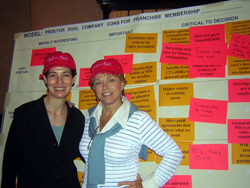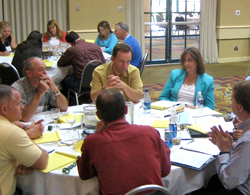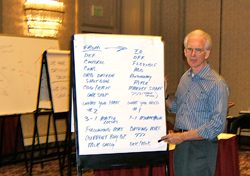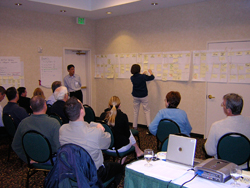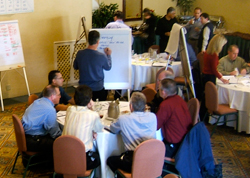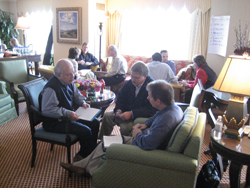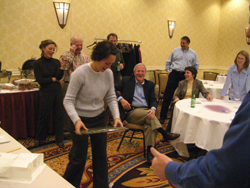Case Studies
The following seven case studies illustrate how we integrate the three aspects of our work:
![]() Top-team Alignment: “Alignment” refers to a sense of coherence or unity that speeds decision making, accelerates change, and builds trust and confidence in a team.
Top-team Alignment: “Alignment” refers to a sense of coherence or unity that speeds decision making, accelerates change, and builds trust and confidence in a team.
![]() Strategy Implementation: Once we achieve alignment at the top, we often expand our work deeper into the organization to support implementation through high-performance, cross-functional teams focused on specific strategy issues.
Strategy Implementation: Once we achieve alignment at the top, we often expand our work deeper into the organization to support implementation through high-performance, cross-functional teams focused on specific strategy issues.
![]() Whole-Systems Change: Whole-systems change often includes support for staffing decisions, executive coaching, culture change, process redesign, and broad-scale capability development.
Whole-Systems Change: Whole-systems change often includes support for staffing decisions, executive coaching, culture change, process redesign, and broad-scale capability development.
What we‘ve learned from our experience
home builder/developer
Top-team alignment focused on strategy, followed by implementation support
Who:
Maracay Homes, a division of Weyerhaeuser, needed to generate a more
competitive strategy in the wake of a collapsed housing market
What:
Top-team
alignment session, 10 weeks of support for implementation teams, followed by a
large-group session
How:
We aligned the
top team around strategic priorities and supported cross-functional teams to
work toward specific goals (reduce cycle time, improve sales execution, improve
land positions, increase quality, etc.). The second offsite event
included 40 senior people representing the “whole system.” This session allowed
for real-time feedback on work conducted to date and generated widespread
commitment for implementing necessary changes.
Impact:
The business
is now well-positioned to increase market share as the housing market rebounds.
“Strategy requires both process and art: a strong commitment and an open mind. Tom Curren makes all this happen simultaneously, and holds us accountable for doing the same.”
Back to Top
government agency
Top-team alignment focused on relationships
Who:
New
York City Housing Commissioner needed to increase trust and alignment between
the “old guard” and “new guard” in light of a changing mission for the department.
What:
Top-team-alignment session focused on relationships, with little follow-up required.
How:
We did
a 1 ½-day offsite followed by individual coaching. Activities included:
- Getting to know and appreciate each other at a deeper level
- Building trust
- Depersonalizing the dynamics among “change agents” and “tradition bearers”
- Having fun together as a team
- Holding a series of dialogues around things that matter most—“elephants in the room”
- Receiving individual feedback and developing personal (behavioral) goals, with optional coaching support
Impact
“We increased the level of candor and trust within my senior staff, cleared some issues that had been difficult to discuss and had a lot of fun, to boot. I didn’t think we could get that much done in a day and a half.”
Back to Top
nonprofit hospital
Series of top team offsite events—initially focused on building relationships, then on implementing cross-functional initiatives
Who:
The Children’s Hospital in Denver needed to quickly align a new
executive team, then clarify accountabilities and tactics for a major set of
strategy initiatives.
What:
A broad diagnostic process guided the design of a sequence of
three executive offsites.
How:
We facilitated an initial offsite to build trust between the new
CEO and his team. Then, following completion of a major strategy effort with
McKinsey & Company, we returned to clarify accountabilities and build
skills in high-performance teamwork.
Impact:
Children’s Denver is well on its way to becoming one of the top children’s hospitals in the country.
“Tom is playing an important role in the momentum we are building here at Children’s Hospital. We now have the trust and tools necessary to successfully execute our plan.”
Back to Top
nonprofit think tank
Whole-system change within a year
Who:
Rocky Mountain Institute, a leading environmental think tank and
consulting firm, wanted to revise its strategy and increase its mission impact.
The organization was “stuck” in its strategy process and frustrated with
chronic high turnover, a lack of focus, and a lack of accountability.
What:
We worked with the CEO and top team to sharpen focus, increase
alignment, and build momentum throughout the organization to generate a new
strategy. Following the strategy effort,
we worked to identify needed culture changes; increase the organization’s external
engagement; improve recruitment and retention; clarify roles and
accountabilities on the senior team; move the culture toward greater
accountability; and strengthen leadership at the top.
How:
We conducted a comprehensive diagnostic process comprising 40
in-depth interviews with staff, board members, and clients, as well as two online
surveys. In the first six months, we advised the top team on strategic
priorities; launched cross-functional work teams to flesh them out; conducted a
large all-staff working session (70 people) to engage the entire organization
in the work; and facilitated the Board’s review of the new strategy. In the second six months, we conducted
intensive leadership assessment and development work at the senior levels of
the organization.
Impact:
RMI has rallied around its
new strategy. Staff members are energized and optimistic, and the Board has
recognized the increased cohesion among top leaders.
“Tom and Allison taught us how to get more done with better collaboration and a happier, more productive team. Their work has made us function at a higher level.”
Back to Top
national for-profit health care organization
Comprehensive whole-system change over three years
Who:
A private equity group brought in a new CEO and charged him with
building Hospice Compassus into the premier for-profit hospice organization in
the country.
What:
Staffing changes, strategy development, culture management, and
executive coaching over a three-year period.
How:
Working with a new CEO, we were sensitive to manage the pace of
needed staffing changes while preserving the best of the existing culture. We
used Cultural Transformation Tools to identify low-performing business units
and instill an organization-wide focus on compassion, integrity, and excellence.
In several two-day sessions, we worked with the top 30 executives to clarify
and align around a new set of strategy initiatives. We remain a “trusted advisor” to the CEO on
sensitive staffing and leadership issues.
Impact:
Since 2007, Hospice Compassus has expanded rapidly and
outperformed its industry peer group.
“What I value most about working with Tom as a business partner is his ability to fully assess business issues, unpack them and rebuild them in an objective, dispassionate manner, resulting in a great game plan. Because Tom is outside the business, although he knows it well, he adds a level of objectivity unavailable to me with any other team member.”
Back to Top
home builder/developer
Innovation and growth over five years
Who:
Winchester Homes wanted to distinguish itself as a
premier residential builder/developer in the highly competitive
Virginia-Maryland market.
What:
Highly participative
strategy development in both the core business and new ventures, top-team
alignment, and culture shifts.
How:
We organized Winchester around “7 cylinders” that defined its long-term success; launched high-performing teams to work on cross-functional
initiatives; accelerated results through large (40 people) Real Time Strategic
Change offsite events; shifted the culture away from “over-involvement” by
clarifying roles and responsibilities; and provided executive coaching for the
CEO.
Impact:
Winchester created a
distinctive positioning around mass customization (“Your Home, Your Way”),
launched a high-end product line and has diversified into retirement housing.
“Beyond helping us develop a focused value-proposition for our core business, working with Tom got us better aligned as a top team, improving communication, trust and performance, which allowed us to enter new business segments more effectively.”
Back to Top
leisure industry
Strategy development over 12 months
Who:
Facing a decline in destination skier visits, Vail
wanted to strengthen market position for its portfolio of resorts (Vail, Beaver
Creek, Breckenridge, and Keystone).
What:
Integrated and coordinated
strategy development process driven by the resort general managers, supported
by Hawthorne Consultants analytical resources.
How:
We conducted a
series of work sessions to identify the source of market declines, create a
more distinctive positioning for each resort, and implement an integrated
approach to capital expenditures.
Impact:
Greater clarity in marketing priorities, and some short-term abatement in market declines.
“Working with Tom on strategy was like moving from playing checkers to playing chess.”
Back to Top
What we’ve learned from our experience
We’re proud of our ability to learn from experience. Here are a few lessons learned:
|
MISTAKES WE DON'T WANT TO REPEAT |
LESSONS LEARNED |
|---|---|
|
Beginning an engagement without a CEO relationship based on a clear and compelling business need |
Scale the work according to what the client is willing and able to absorb and implement |
|
Losing touch with our CEO client |
Maintain a close partnership with the client at every step of the work |
|
Extending work out to strategy teams without a sufficiently solid and aligned top team |
Divide the work into chunks or steps to produce rapid results and gain the experience/learning that enables further progress |
|
Initiating broad-based culture change before the top-team alignment, staffing, and structure work is complete |
Phase the work in the following order: Alignment, strategy, decision-driven change (staffing, structure, etc.), THEN culture and behavior change. |


